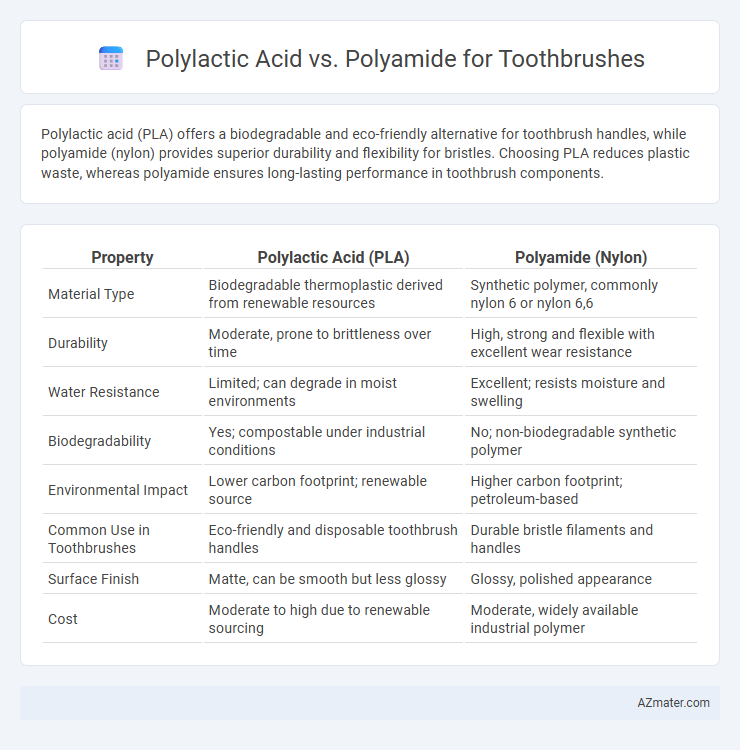Polylactic acid (PLA) offers a biodegradable and eco-friendly alternative for toothbrush handles, while polyamide (nylon) provides superior durability and flexibility for bristles. Choosing PLA reduces plastic waste, whereas polyamide ensures long-lasting performance in toothbrush components.
Table of Comparison
| Property | Polylactic Acid (PLA) | Polyamide (Nylon) |
|---|---|---|
| Material Type | Biodegradable thermoplastic derived from renewable resources | Synthetic polymer, commonly nylon 6 or nylon 6,6 |
| Durability | Moderate, prone to brittleness over time | High, strong and flexible with excellent wear resistance |
| Water Resistance | Limited; can degrade in moist environments | Excellent; resists moisture and swelling |
| Biodegradability | Yes; compostable under industrial conditions | No; non-biodegradable synthetic polymer |
| Environmental Impact | Lower carbon footprint; renewable source | Higher carbon footprint; petroleum-based |
| Common Use in Toothbrushes | Eco-friendly and disposable toothbrush handles | Durable bristle filaments and handles |
| Surface Finish | Matte, can be smooth but less glossy | Glossy, polished appearance |
| Cost | Moderate to high due to renewable sourcing | Moderate, widely available industrial polymer |
Introduction to Biodegradable and Synthetic Toothbrush Materials
Polylactic acid (PLA) is a biodegradable polymer derived from renewable resources such as cornstarch, offering an eco-friendly alternative to traditional synthetic materials used in toothbrushes. Polyamide, commonly known as nylon, is a synthetic polymer renowned for its durability, flexibility, and resistance to wear, but it poses environmental challenges due to its non-biodegradable nature. In toothbrush manufacturing, the comparison between PLA and polyamide highlights a balance between sustainability through biodegradability and performance through synthetic resilience.
Overview of Polylactic Acid (PLA) in Oral Care
Polylactic acid (PLA) is a biodegradable thermoplastic derived from renewable resources like corn starch and sugarcane, making it an eco-friendly alternative in oral care products such as toothbrushes. PLA offers high biocompatibility, compostability, and sufficient mechanical strength for daily brushing applications, reducing plastic waste in the environment. Its natural origin and biodegradability position PLA as a sustainable material choice compared to conventional polyamide, which is petroleum-based and non-biodegradable.
Key Properties of Polyamide for Toothbrush Manufacturing
Polyamide, known for its excellent mechanical strength, flexibility, and resistance to abrasion, is a preferred material in toothbrush manufacturing, ensuring durability during daily use. Its inherent resistance to moisture and chemicals makes polyamide ideal for maintaining structural integrity despite regular exposure to water and toothpaste compounds. The high melting point and ease of molding enable precise bristle design and robust handle construction, enhancing overall toothbrush performance.
Environmental Impact: PLA vs Polyamide
Polylactic acid (PLA) toothbrushes offer significant environmental advantages due to their biodegradable nature and derivation from renewable resources like corn starch, which reduces reliance on fossil fuels and decreases plastic pollution. In contrast, polyamide toothbrushes, typically made from petroleum-based nylon, have a longer degradation period and contribute more substantially to microplastic contamination and carbon emissions during production. PLA's compostability under industrial conditions and lower overall carbon footprint make it a more sustainable choice for eco-conscious oral care products compared to conventional polyamide materials.
Durability and Lifespan Comparison
Polylactic acid (PLA) toothbrushes exhibit moderate durability with a lifespan typically ranging from 1 to 3 months, as PLA is biodegradable but less resistant to mechanical stress and moisture over time. Polyamide (nylon) toothbrushes offer superior durability and a longer lifespan, often extending beyond 3 months, due to their high tensile strength, flexibility, and resistance to wear and water exposure. The enhanced mechanical properties of polyamide make it a preferred material for long-lasting toothbrushes compared to the more eco-friendly but less durable PLA.
Bristle Performance and Oral Health Implications
Polylactic acid (PLA) bristles offer biodegradability and a gentler texture, reducing gum irritation compared to polyamide bristles, which provide superior durability and consistent stiffness for effective plaque removal. PLA bristles may soften quickly in warm water, potentially decreasing cleaning efficiency, while polyamide maintains resilience over time, promoting better long-term oral hygiene. Studies indicate that polyamide bristles contribute to improved plaque control and gum health, whereas PLA's biodegradable nature supports environmental sustainability without compromising basic oral care.
Comfort and User Experience
Polylactic acid (PLA) toothbrushes provide a lightweight and biodegradable option with smooth bristle flexibility, enhancing comfort during use without compromising environmental sustainability. Polyamide handles offer superior durability and ergonomic design, contributing to better grip and long-lasting user experience but lack the eco-friendly benefits of PLA. Users seeking a balance between comfort and sustainability often prefer PLA, while those prioritizing robustness and grip stability lean towards polyamide toothbrushes.
Cost Analysis of PLA vs Polyamide Toothbrushes
Polylactic acid (PLA) toothbrushes generally have a lower production cost compared to polyamide toothbrushes due to the renewable sourcing of PLA and simpler manufacturing processes. Polyamide toothbrushes, while offering superior durability and flexibility, incur higher material and processing expenses, driving up the final retail price. Cost analysis reveals PLA toothbrushes provide an economical eco-friendly alternative, whereas polyamide options cater to consumers prioritizing longevity despite a steeper price point.
Market Trends and Consumer Preferences
Polylactic acid (PLA) toothbrushes are gaining traction in the eco-conscious market due to their biodegradability and renewable plant-based origins, aligning with rising consumer demand for sustainable products. Polyamide toothbrushes, known for their durability and flexibility, maintain popularity in performance-focused segments but face challenges from increasing environmental scrutiny. Market trends indicate a growing shift toward PLA as manufacturers and consumers prioritize eco-friendly alternatives without compromising functionality.
Conclusion: Choosing the Optimal Material for Toothbrushes
Polylactic acid (PLA) offers biodegradability and a lower environmental impact compared to polyamide, making it ideal for eco-friendly toothbrush designs. Polyamide provides superior durability and resistance to moisture, ensuring longer-lasting performance and structural integrity. Selecting between PLA and polyamide depends on balancing sustainability priorities with the need for strength and longevity in toothbrush materials.

Infographic: Polylactic acid vs Polyamide for Toothbrush
 azmater.com
azmater.com